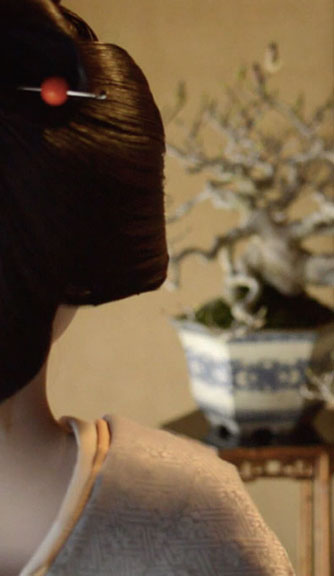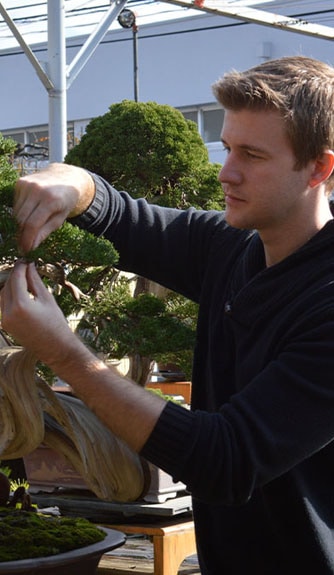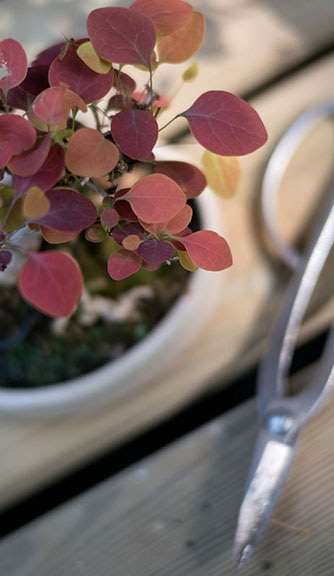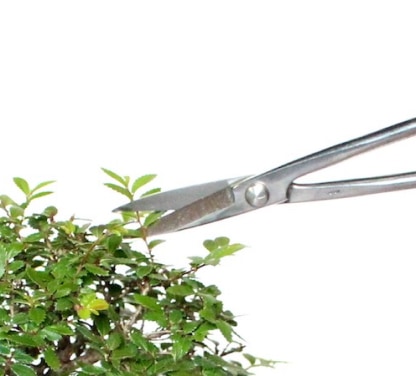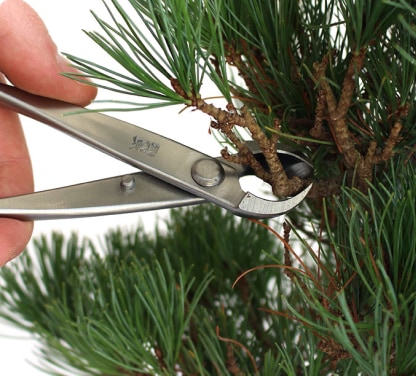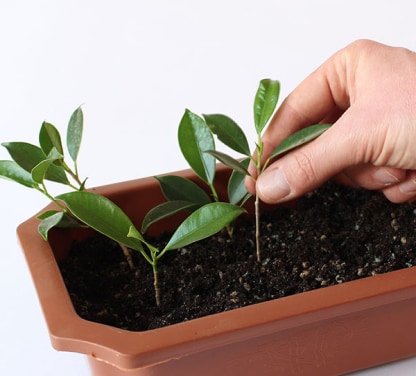Introduction to Bonsai techniques
Bonsai is an art that has been studied and refined for centuries, but don't let that scare you off. With a little guidance, you're perfectly capable of growing your very own Bonsai trees without a mystical green thumb. Make sure you choose a tree species that is suited for the climate in your area and stick to the basic care guidelines. In this section, I'll explain how to start growing Bonsai and introduce you to the three main techniques: cultivation, styling, and care.
Growing and cultivating trees
How do you grow your own Bonsai tree? The first step is to figure out which tree species suits your needs, climate, and circumstance. Whether you prefer to keep your tree indoors, or outdoors will have a big impact on your selection. Growing Bonsai indoors limits your options to subtropical trees that can survive indoors. Whereas growing your Bonsai outdoors gives you more options to choose from. Most non-tropical trees are perfectly fitted to grow outdoors, as long as they are protected from intense sunlight or freezing temperatures. Choosing an indigenous tree for your area is the safest bet. This short Bonsai orientation will help you select an indoor Bonsai, or outdoor tree that best meets your criteria.
![]() Now that we've selected the best tree species for you, let's take a look at how you can actually get one! The easiest thing to do is to buy a ready-made Bonsai tree from an online store. You can choose from a wide variety of tree species that come in many shapes and sizes, but they come with a hefty price tag, especially the older ones. A more economical approach is to purchase pre-bonsai or nursery stock, which is a great way to achieve quick results!
Now that we've selected the best tree species for you, let's take a look at how you can actually get one! The easiest thing to do is to buy a ready-made Bonsai tree from an online store. You can choose from a wide variety of tree species that come in many shapes and sizes, but they come with a hefty price tag, especially the older ones. A more economical approach is to purchase pre-bonsai or nursery stock, which is a great way to achieve quick results!
![]() An even cheaper approach is to collect trees from your natural surroundings, but it can be quite tricky, and you must ask for permission from the landowner before uprooting any trees... And if those options don’t sound appealing to you, we’ve created our very own Bonsai starter kits to create your own Bonsai tree, for you to follow along, and learn all the fundamentals of Bonsai.
An even cheaper approach is to collect trees from your natural surroundings, but it can be quite tricky, and you must ask for permission from the landowner before uprooting any trees... And if those options don’t sound appealing to you, we’ve created our very own Bonsai starter kits to create your own Bonsai tree, for you to follow along, and learn all the fundamentals of Bonsai.
![]() A less expensive and very slow method is to cultivate your own tree using seeds or cuttings. It will normally take around 3-5 years before a young tree can be styled, so you might want to do this as a side project, and buy a pre-bonsai to get started with styling techniques sooner.
A less expensive and very slow method is to cultivate your own tree using seeds or cuttings. It will normally take around 3-5 years before a young tree can be styled, so you might want to do this as a side project, and buy a pre-bonsai to get started with styling techniques sooner.

Nursery stock or prebonsai material

Pruning and wiring to shape the tree

The end result after repotting
Shaping and styling techniques
Now that you've bought or cultivated a tree, let's get started with shaping and styling it. This is the creative and fun part of growing Bonsai, but it's also the most challenging part. Although it can take years to truly master and refine techniques like pruning and wiring to keep trees miniaturized, some basics can be learned quite easily. We'll start with the basics of pruning and wiring, but make sure to read the "styling" section for more detailed information.
“Bonsai is not a race, nor is it a destination. It is a never-ending journey.”
![]() Let's begin with the single most important technique to Bonsai, pruning. Pruning is a crucial practice used to shape trees and keep them miniature. The goal is to create a Bonsai that accurately replicates a miniature version of a full-scale tree in its natural environment. The best time to prune your tree is during Spring, although there are some differences depending on the type of tree you have. Make sure to buy a good pair of concave cutters when pruning thick branches. They create a more hollow wound that heals much better than those made by standard cutters. Though I can’t tell you which branches to prune without actually seeing your tree, it's very helpful to look at some Bonsai progressions examples. Some instances in which a branch should be removed include:
Let's begin with the single most important technique to Bonsai, pruning. Pruning is a crucial practice used to shape trees and keep them miniature. The goal is to create a Bonsai that accurately replicates a miniature version of a full-scale tree in its natural environment. The best time to prune your tree is during Spring, although there are some differences depending on the type of tree you have. Make sure to buy a good pair of concave cutters when pruning thick branches. They create a more hollow wound that heals much better than those made by standard cutters. Though I can’t tell you which branches to prune without actually seeing your tree, it's very helpful to look at some Bonsai progressions examples. Some instances in which a branch should be removed include:
- When there are two branches at the same height on the tree trunk, cut one, and keep the other.
- If you have a branch with unnatural twists and turns.
- If you notice disproportionately thick branches at the top of the tree
![]() Another important technique to shape Bonsai trees is wiring. By carefully wrapping anodized aluminum, or annealed copper, around branches you can bend and shape them to your will, at least to a certain extent. Wiring can be applied year-round, but make sure to remove the wire promptly before it starts digging into branches that grow thicker. Make sure to read the wiring page in the styling section for more detailed instructions.
Another important technique to shape Bonsai trees is wiring. By carefully wrapping anodized aluminum, or annealed copper, around branches you can bend and shape them to your will, at least to a certain extent. Wiring can be applied year-round, but make sure to remove the wire promptly before it starts digging into branches that grow thicker. Make sure to read the wiring page in the styling section for more detailed instructions.
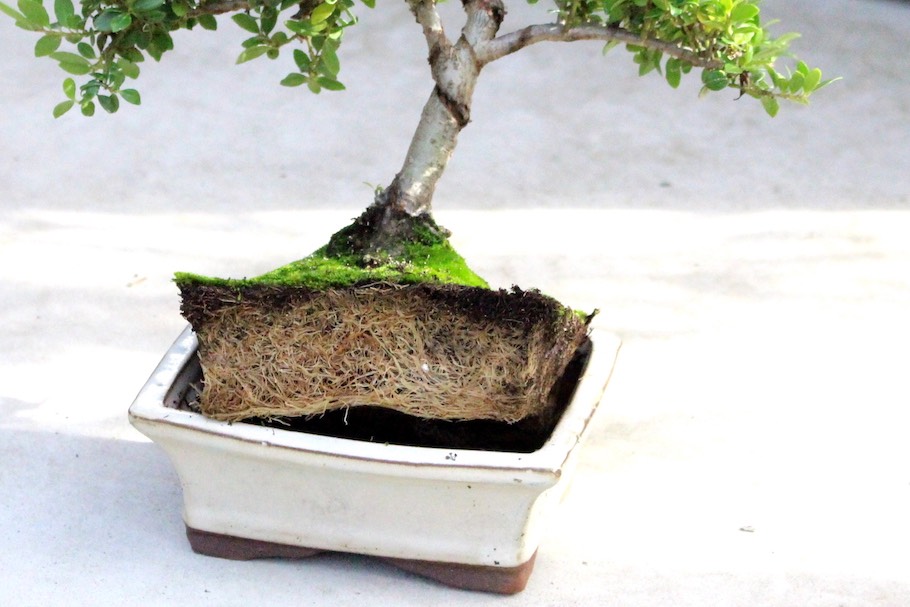
Care and maintenance
Maintenance and care is a crucial part of growing a Bonsai tree. Although every tree species has its specific care guidelines, I'll discuss some of the basics beginning with watering. Be sure to identify your Bonsai for specific instructions.
![]() How much and with what frequency you should water a Bonsai depends on a wide range of factors, such as; tree species, pot size, soil-mixture, and climate. Because Bonsai are usually planted in such small pots, they tend to dry up fairly quickly, so it's important to water your Bonsai regularly. However, over-watering can result in root-rot. Choosing the right soil mixture for your Bonsai and re-potting regularly is crucial to keep your tree healthy. Most Bonsai need to be repotted every 2 years to make sure the trees don’t become pot-bound, which makes it harder to soak up and store water. An important rule for watering is to keep a close eye on your tree and soil and water when necessary, rather than watering once a day, or on a schedule. Water your Bonsai thoroughly to make sure the soil absorbs water properly.
How much and with what frequency you should water a Bonsai depends on a wide range of factors, such as; tree species, pot size, soil-mixture, and climate. Because Bonsai are usually planted in such small pots, they tend to dry up fairly quickly, so it's important to water your Bonsai regularly. However, over-watering can result in root-rot. Choosing the right soil mixture for your Bonsai and re-potting regularly is crucial to keep your tree healthy. Most Bonsai need to be repotted every 2 years to make sure the trees don’t become pot-bound, which makes it harder to soak up and store water. An important rule for watering is to keep a close eye on your tree and soil and water when necessary, rather than watering once a day, or on a schedule. Water your Bonsai thoroughly to make sure the soil absorbs water properly.
![]() Placing an outdoor tree inside, or vice versa is a sure way to kill your Bonsai. Before purchasing or cultivating you should decide where to place your tree. Sub-tropical trees will do perfectly fine indoors, though they generally need a lot of light and relatively high humidity. They can only be grown outdoors if you live somewhere with a warm enough climate. If you're more interested in an outdoor tree, it's best to choose one that is native to your environment. Please note, even trees that are indigenous to your area may require some additional protection from frost during cold winters. Because of their small and shallow pots, they are more susceptible to frost.
Placing an outdoor tree inside, or vice versa is a sure way to kill your Bonsai. Before purchasing or cultivating you should decide where to place your tree. Sub-tropical trees will do perfectly fine indoors, though they generally need a lot of light and relatively high humidity. They can only be grown outdoors if you live somewhere with a warm enough climate. If you're more interested in an outdoor tree, it's best to choose one that is native to your environment. Please note, even trees that are indigenous to your area may require some additional protection from frost during cold winters. Because of their small and shallow pots, they are more susceptible to frost.
![]() Besides watering, placement and repotting, fertilization is another important thing to keep in mind. Small pots with little space limit water and nutrient retention. Fertilizing regularly in the tree's growing season is key to make sure your tree stays healthy and thrives. Again, the amount and frequency with which you fertilize your Bonsai depends on the tree species you have. Which brand and/or type of fertilizer you choose won't have a major effect on your plant. You can use solid or liquid fertilizer as long as you make sure to apply smaller quantities than normal plants require.
Besides watering, placement and repotting, fertilization is another important thing to keep in mind. Small pots with little space limit water and nutrient retention. Fertilizing regularly in the tree's growing season is key to make sure your tree stays healthy and thrives. Again, the amount and frequency with which you fertilize your Bonsai depends on the tree species you have. Which brand and/or type of fertilizer you choose won't have a major effect on your plant. You can use solid or liquid fertilizer as long as you make sure to apply smaller quantities than normal plants require.
Conclusion, how to make a Bonsai tree?
This introductory article covered the three steps of growing Bonsai; cultivation, styling, and care. And, although Bonsai is a centuries-old living art form, getting started with this fascinating hobby is not difficult! This website will help you to get started and our forum is the best place to ask for advice. If you already have your tree, but need help, read our "Help! My Bonsai is dying" article.
We've created several online courses with world-renowned Bonsai experts, for more information and free lessons, check out our Bonsai Courses. You can also find local Bonsai clubs that organize highly recommended courses and workshops. Good luck!
Enroll in a course
Subcategories
Bonsai tree care
Bonsai tree care Though Bonsai trees are more delicate than the average indoor plant, a few basic rules should enable anyone to take care of their tree properly. Pay particular attention to where you place it and how to water it properly. In this section...
Read moreBonsai styling
Styling and shaping a Bonsai tree The styling of Bonsai trees includes basic methods like regular pruning and wiring, but also more advanced techniques including the creation of deadwood. We apply these techniques to promote growth, manipulate our trees into the shape we desire, and...
Read moreTree cultivation
Aquiring Bonsai material In this part of our website we explain how to cultivate your very own Bonsai tree. You'll get detailed information about all the different Bonsai propagation techniques, everything from purchasing a pre-made Bonsai tree, to growing your very own tree and...
Read moreGeneral
Our recommendations A quick guide to selecting quality tools and Bonsai books that will help you succeed in growing and caring for your Bonsai. Important tools include a twig shear with a long handle, and a concave cutter. As for books; there are literally hundreds of books available....
Read more

